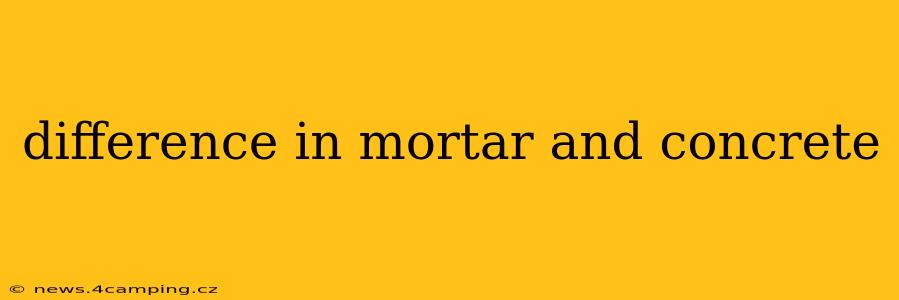Mortar and concrete are both building materials made from a mixture of cement, aggregates, and water, but their composition, properties, and applications differ significantly. Understanding these differences is crucial for any construction project, ensuring the right material is used for the job. This guide will delve into the specifics, answering common questions and clarifying the distinctions between these two essential construction materials.
What is Mortar?
Mortar is a binding agent primarily used to join masonry units like bricks, blocks, and stones. It's a mixture of cement (or sometimes lime), fine aggregates (like sand), and water. The key characteristic of mortar is its plasticity and workability, allowing it to be easily shaped and applied between masonry units. It's designed to create a strong, durable bond that holds the structure together.
What is Concrete?
Concrete is a composite material, typically made of cement, aggregates (such as gravel, crushed stone, or recycled materials), water, and often chemical admixtures to modify its properties. Unlike mortar, concrete is designed for structural purposes. It can support significant compressive loads, making it the primary material for foundations, slabs, walls, and other structural elements. The coarser aggregates in concrete give it much greater strength and density compared to mortar.
What are the Key Differences Between Mortar and Concrete?
Here's a table summarizing the key distinctions:
| Feature | Mortar | Concrete |
|---|---|---|
| Primary Use | Binding masonry units | Structural applications |
| Aggregates | Fine (primarily sand) | Coarse (gravel, crushed stone, etc.) |
| Strength | Relatively low compressive strength | High compressive strength |
| Workability | High, easily shaped and applied | Lower workability, requires tools |
| Water-Cement Ratio | Higher | Lower |
| Typical Application | Bricklaying, stonework, blocklaying | Foundations, slabs, walls, beams |
What are the Ingredients of Mortar and Concrete?
Both mortar and concrete utilize cement as a binder, but the type and quantity can vary. The aggregates differentiate them the most. Mortar uses fine sand, while concrete utilizes larger aggregates like gravel or crushed stone. The water-cement ratio also influences the final properties; concrete generally has a lower water-cement ratio for higher strength. Chemical admixtures are commonly added to concrete to control setting time, workability, and other properties, but are less frequently used in mortar.
What is the Difference in Strength Between Mortar and Concrete?
Concrete possesses considerably higher compressive strength than mortar. This is because of the larger, coarser aggregates used in its composition. Concrete's high strength allows it to bear significant weight and withstand considerable pressure, making it ideal for structural elements. Mortar, while strong enough to bind masonry units, isn't designed to bear significant compressive loads on its own.
How Do I Choose Between Mortar and Concrete?
The choice depends entirely on the application. If you're building a wall with bricks, blocks, or stones, you'll need mortar to bind the units together. If you're building a foundation, a slab, or other structural element, concrete is the appropriate material due to its superior strength and load-bearing capacity.
What are the Different Types of Mortar?
Mortar types are classified by their strength and composition. Common types include Type N (general purpose), Type S (medium strength), and Type M (high strength). The choice of mortar depends on the application and the load requirements.
What are the Different Types of Concrete?
Concrete types vary depending on the mix design, intended use, and required properties. These can include high-strength concrete, self-consolidating concrete, and fiber-reinforced concrete. Each type is engineered for specific applications.
This detailed comparison clarifies the distinctions between mortar and concrete. Remember to consult with a qualified construction professional for any specific project to ensure the correct materials and techniques are used for optimal results and safety.
